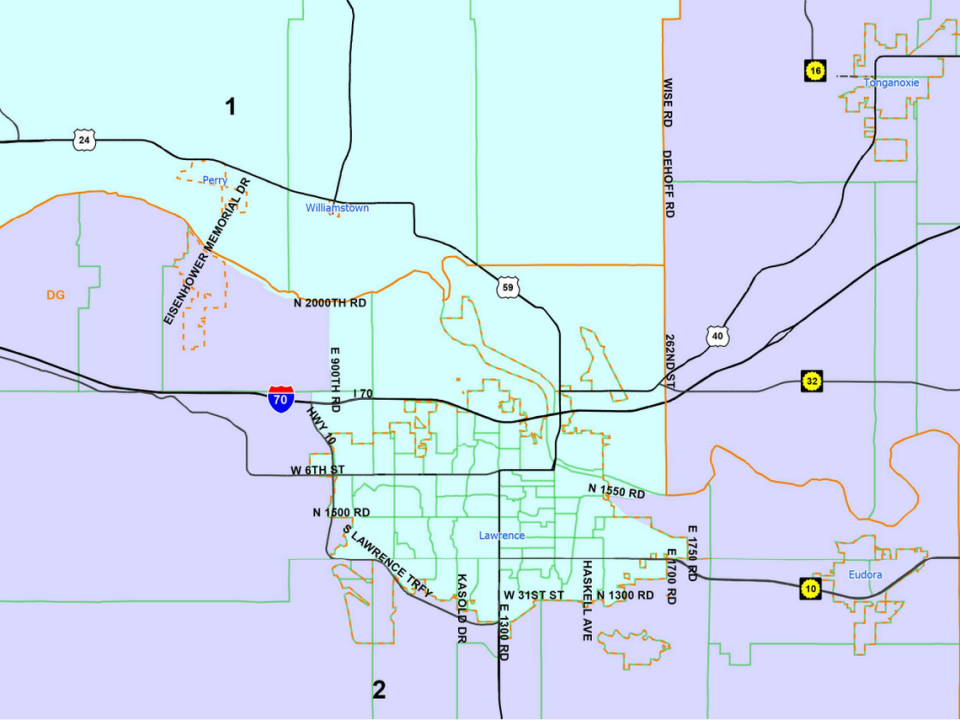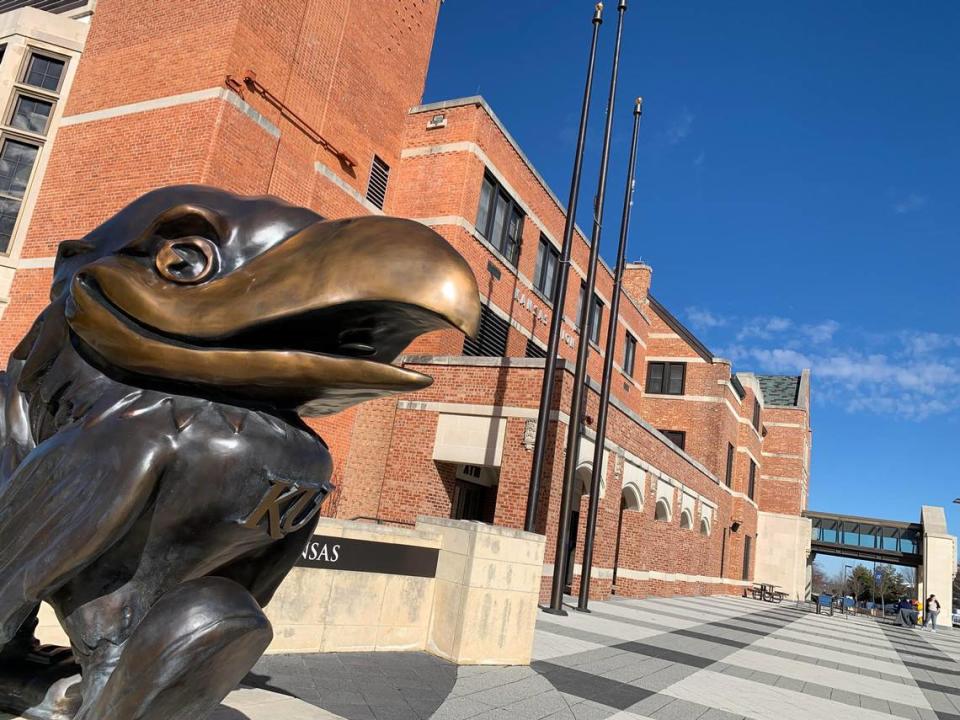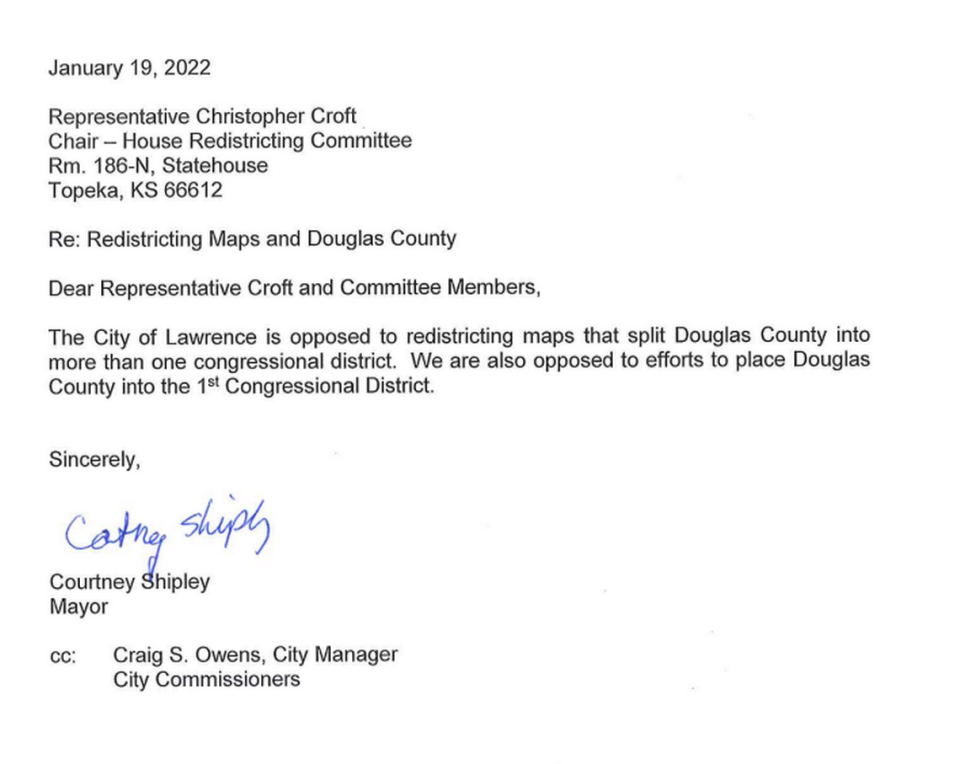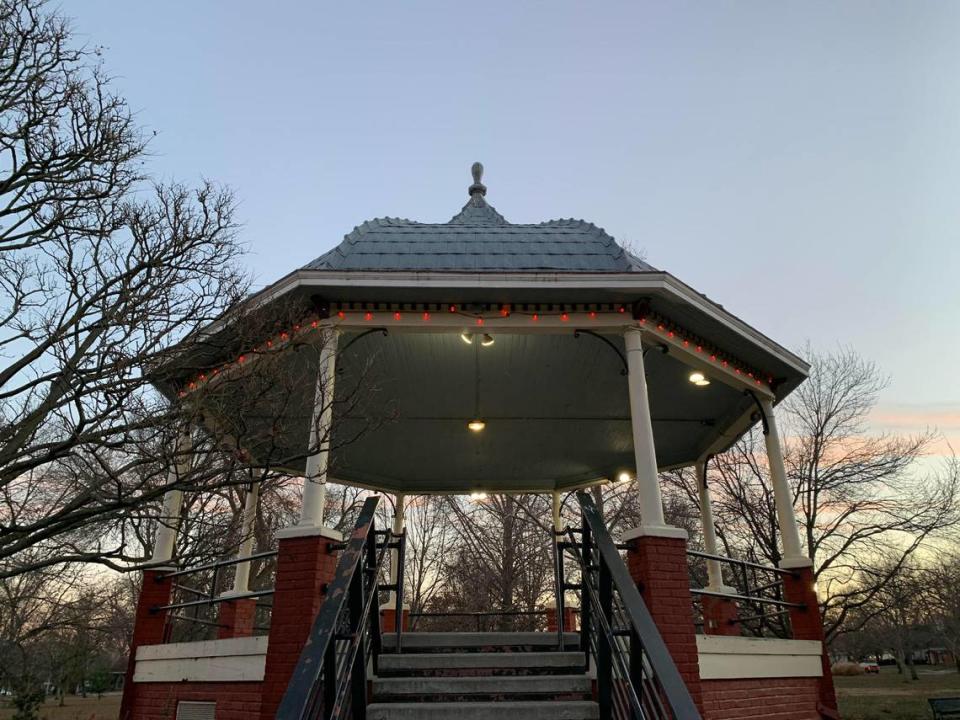Liberal stronghold Lawrence fears getting gerrymandered into rural Kansas district
Every year, Lawrence Free State High School social studies teacher Blake Swenson walks his students through redistricting, the crucial once-a-decade redrawing of congressional and legislative boundaries to account for shifts in population.
The students test out online mapping tools that let them draw their own districts and discover just how hard it is to make them equal, as required by federal law. And Swenson covers the less savory elements of the process, too — the raw politics that can lead to gerrymandering.
So when Republican lawmakers proposed a congressional map last week that would move Lawrence out of its current home in the eastern Kansas 2nd District and into the western and north central 1st District, the idea didn’t shock him.
“I wasn’t too surprised they would try to do this just because this has kind of been the trend,” Swenson said.
Lawrence, home to the University of Kansas and long a liberal stronghold in a conservative state, is bracing for the possibility it will spend the next 10 years in the Big 1st – a vast Republican expanse that currently stretches from just west of Topeka to the Colorado border.
The Kansas Senate on Friday passed a congressional map that would extend the 1st further east, snaking north of Topeka then south to snatch up Lawrence. On Monday, a House committee advanced an identical proposal to the full House, a sign the Republican-controlled Legislature is bent on sending the plan to Democratic Gov. Laura Kelly.
The House debated the plan on Tuesday. GOP leaders defeated several attempts to amend the map. A final vote is expected Wednesday.
Lawrence is no stranger to being tossed around in redistricting. From the early 70s until 2002, the city flipped between the 2nd and 3rd District every 10 years. Then lawmakers split the city between the two districts before federal judges drew maps in 2012 that returned it all back into the 2nd.
But never before has Lawrence – a college hub less than an hour’s drive from downtown Kansas City – stood at the edge of being pushed into the rural western 1st.
“I think there’s definitely political gerrymandering going on … ever since I’ve lived in Lawrence, we’ve just changed our district,” said Swenson, who moved to the city in 2000.
The idea of moving one of Kansas’s bluest cities into its reddest district, combined with the speed at which lawmakers are moving, has sent community leaders and activists scrambling. They’re frustrated and angered not only by what appears to be a brazen political power play, but also what they see as the absurdity of dropping one of the state’s most urban communities into a traditionally rural, agriculturally-focused district.
The city didn’t feature prominently in public redistricting discussions leading up to the start of the legislative session earlier this month. Much of the attention focused on the 3rd District, which encompasses the Kansas City metro and whether Democratic-leaning Wyandotte County would be split apart or severed from Johnson County, where Democrats have made gains in recent years.
“I didn’t expect something like this,” Pat Willer, chair of the Douglas County Democratic Party, said.

Gerrymandering seen in map
Douglas County, home to Lawrence, currently sits entirely in the 2nd, which includes all of eastern Kansas with the exception of the Kansas City metro. The map passed by the Senate – called “ad astra” among lawmakers – leaves the county in the 2nd except for Lawrence.
The city, with nearly 95,000 residents in the northern part of the county, would be scooped out of the 2nd into the 1st with a bowl-shaped line running south of the city.
“I think visually, looking at that specific little notch, it makes so little sense,” Willer said. “It just kind of drives home the notion of gerrymandering.”
Republicans control three of the state’s four congressional districts. Since 2020, some Republicans have signaled they believe the map can be redrawn to weaken the delegation’s sole Democrat, Rep. Sharice Davids of the 3rd.
But shifting Lawrence into the 1st suggests Republicans are embarking on an even more ambitious project that would not only undermine Davids, but also shore up GOP control over the 2nd.
Under the ad astra map, part of Wyandotte County would move from the 3rd into the 2nd. The switch would be offset by taking Lawrence out of the 2nd.

Republicans have held the 2nd District for the past decade but it has at times been competitive. Democrats nearly captured the seat in 2018, when Lawrence attorney Paul Davis, a former candidate for governor, ran against Republican Steve Watkins. Watkins, who suffered from numerous controversies and a divisive primary, won by 2,239 votes or less than 1 percentage point.
Republicans hold unquestioned command of the 1st, however. GOP Rep. Tracey Mann won more than 71% of the vote in 2020. With that kind of margin, the party is betting Mann can afford to absorb Lawrence’s Democrats without risk.
Rep. Barbara Ballard, a Lawrence Democrat, said she couldn’t understand how moving Lawrence can be justified. “People may not like that Lawrence is more liberal, votes blue, though it has a lot of Republicans there too,” she told a committee hearing on Monday.
As of June, 45% of registered voters in Douglas County were Democrats and 26% were Republicans.
Top Republicans have offered only a few perfunctory non-political explanations for the ad astra map.
Senate Vice President Rick Wilborn, a McPherson Republican who chairs the Senate Redistricting Committee, said during debate that the Board of Regents a decade ago had wanted the schools kept together.
And, he said, it “didn’t cross my mind” that moving Lawrence out of the 2nd would make up for new Democrats in the district from Wyandotte County.
Senate President Ty Masterson, an Andover Republican, has emphasized that Lawrence and Manhattan would both be in the 1st district, grouping the University of Kansas and Kansas State University together.
“I don’t know how you would contest that Lawrence and Manhattan aren’t similar in their interests. It made a lot of sense to put the universities back together,” Masterson said.
Matt Keith, Board of Regents spokesman, said the board hasn’t taken a position or offered testimony on any aspect of redistricting.

KU student engagement lacking
Although Republicans are angling to move KU into a new district, the fight over the congressional map hasn’t attracted the attention of students, said Ryan Reza, a senior studying political science and global and international relations.
Reza, president of Kansas Young Democrats, said that while he appreciates the efforts of some groups to raise awareness, “I think that historically, students have not cared about redistricting – not because they don’t care but because they’re not as informed and aware of the process as they should be.”
For his part, Reza’s objections go beyond partisan politics and include concerns about dividing Lawrence, where he plans to live after graduation, and Topeka, where he grew up.
“The two communities are so tight-knit because a lot of younger folks who work in Topeka live in Lawrence,” Reza said.
Some Lawrence leaders are sidestepping the partisan aspects of the redistricting fight, instead focusing on the economic, cultural and community reasons a move to the 1st doesn’t make sense.
Both the Lawrence Chamber of Commerce and the City of Lawrence have gone on record opposing the ad astra map.
“The City of Lawrence is opposed to redistricting maps that split Douglas County into more than one congressional district. We are also opposed to efforts to place Douglas County into the 1st Congressional District,” Mayor Courtney Shipley wrote in a letter to lawmakers dated Jan. 19.
Shipley didn’t elaborate in her letter and didn’t respond to an interview request.

In its letter, the Chamber of Commerce focused on urging lawmakers to keep Douglas County intact. Criteria for redistricting include the compactness of districts, preservation of political communities, racial fairness, equal population and partisan fairness, the letter said, alleging the ad astra map “violates several of these criteria.”
“Lawrence has never been in district one and I think for obvious reasons,” Hugh Carter, vice president of external affairs at the Lawrence Chamber of Commerce, said in an interview. “It isn’t a good fit. It’s an ag region.”
Zack Pistora, who sits on the board of the Kansas Rural Center, an agricultural advocacy group, also questioned the connection between Lawrence and western side of the state. How is a U.S. representative supposed to reconcile the interests of the southwest tip of Kansas with the interest of Lawrence residents, he asked.
“It would just be a stretch,” said Pistora, who lives outside Lawrence in Leavenworth County and would remain in the 2nd district under the ad astra map.

Lawsuit over congressional map?
If the House approves the ad astra map without changes, it will go to Democratic Gov. Laura Kelly. The governor hasn’t said she will veto the map, but told reporters last week she wanted communities of interest maintained.
The House and Senate would need two-thirds majorities to override a veto. The Senate could likely achieve the necessary support but it’s less clear whether the House has the votes.
The ad astra map would almost certainly face a lawsuit if it becomes law, however. Opponents would likely allege the districts aren’t compact and lawmakers haven’t done enough to preserve communities of interest.
“I would expect there would be court challenges,” said Cille King, advocacy chair for the Kansas League of Women Voters who is also involved in the group’s Douglas County chapter.
Regardless of whether the ad astra map is ultimately enacted, Carter said the way the Legislature has conducted redistricting has been disappointing. With the candidate filing deadline not until June, lawmakers have the entire session to approve a map.
“So to push something, especially with some of the things that we think are clearly at least not in this community’s best interest, so quickly that we can barely scramble and get the leadership in this county all together to even express an opinion is disappointing,” he said.

